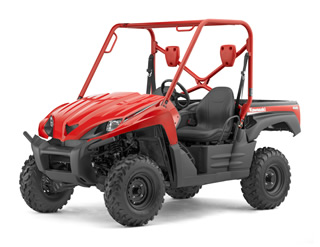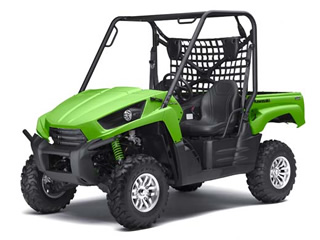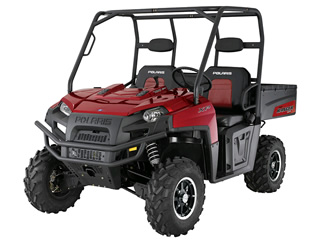Back in the day, 4 years ago, there were just a few UTVs to choose from. The Polaris Ranger, John Deere, the Kawasaki Mule and a few others that really offered nothing more than a vehicle to work around the ranch or farm at speeds around 30 mph. When the Yamaha Rhino came out in 2004 it defined a whole new bread of Utility Terrain Vehicles that would set a president for vehicles to come. Polaris stepped up with the Ranger XP as well as the new Ranger RZR, Arctic Cat created the Prowler, and now Kawasaki adds to their line up the Teryx. All vehicles have work in mind, but also have a great fun factor that travel over the 40 mph mark and have great off-road capabilities and the Kawasaki Teryx ranks high in this sport/work vehicle combo.
We have heard that Kawasaki has been working on a new sportier vehicle that would be in contention with the previous mentioned and only imagined what it could be. The biggest thing UTV aficionados hoped for was that they would include a “Brute Force” engine from their ATV line. Kawasaki did not disappoint us on the power plant, suspension, and overall look of the new Teryx. These three key features are just a few that make the Kawasaki Teryx stand out and will be a force to reckoned with. Will the Teryx devour the competition? Read on.
ENGINE & TRANSMISSION
What gets the Teryx rolling is a 749cc liquid-cooled, 90-degree, four-stroke V-twin engine. This is the same engine that has been proven in Kawasaki’s Brute Force 750 4×4, giving
the Teryx 750 a displacement over most and a V-twin torque advantage similar to the Polaris RZR. The acceleration is smooth up to its 48mph top end and very little noticeable vibration. While the Teryx is not the quickest we have tested, we also know that this motor is significantly detuned. Add a CDI and exhaust to uncork some power and you should be able to get these numbers close to 60mph. Kawasaki wanting to get this unit to the market as soon as possible went with dual CVKR-34 downdraft carburetors and is already working on a fuel-injected model. Mated to the engine is Kawasaki’s superb constant velocity automatic transmission (CVT), which transfers the power from the big V-twin to the wheels smoothly and quickly. The only drawback to this configuration was the location of the CVT. Rather than on the driver’s side it resided on the passenger side next to the fuel tank. Changing a belt would require taking it to a dealer, or for the do-it-yourselfer, removing the fuel tank to gain access. Kawasaki rates the belt life on the Teryx to be around 200 hours so keep track of you handy hour meter located on the dash.
BRAKING
With power comes stopping and Kawasaki went with a combination of dual 200mm discs up front and a sealed wet brake in the rear. The sealed wet rear brake is a great system especially when the trail is wet or muddy keeping out the elements that might reduce braking effectivness. Braking in the Teryx was not noticeably quick but we never felt like we needed more. The parking brake is set up truck style. Located on the left of the brake and accelerator pedal you have quick easy access to. At first this location was odd but at the end of a days ride it became natural.
SUSPENSION
From Kawasaki they state that the Teryx has long travel in the front and rear. While not the typical 3” over or 6” over long travel kits we see common in the market today the Teryx a-arms are 2” wider per side over the Yamaha Rhino. In essence making the Kawasaki’s suspension travel more. Although rated at the same suspension travel (7.3) as the Rhino, the Kawasaki’s ride quality is noticeably better than the Rhino. This is due to the gas-charged shocks in the front and gas-charged reservoir shocks in the rear for increased driver and passenger comfort. With 11.25 inches of ground clearance, the Teryx easily maneuvered over rocks and the suspension absorbed the biggest of jumps. At 58.3 inches wide, the additional width is a welcome extra for those off-roaders  in open spaces. The Kawasaki while wider than a Rhino and RZR will still fit between the rails of full-size trucks.
in open spaces. The Kawasaki while wider than a Rhino and RZR will still fit between the rails of full-size trucks.
LOOKS AND ERGONOMICS
Walking up to the Teryx you’ll notice its Rhino-esque appeal with refined features starting off with the nicely sculpted front hood molded from thermoplastic olefin. You’ll also notice the Teryx has wide, sculpted fenders on the front and rear. The cage is a true ROPS (Roll-Over Protective Structure) design unlike it’s competitors. While roll overs are unlikely in the stable Teryx, it’s reassuring that you have a cage that will do its job. The cargo bed with its 500lb carrying capacity is heavy-duty steal much like the Kawasaki Mule and the LE models include the gas-assisted tilt bed the standard model is stationary. All models include four anchor points on the inside of the bed as well as a cargo net to keep your gear intact. Once in the Teryx the interior felt comfortable with plenty of room for the biggest of drivers. Comfortable molded seats and a three-point restraint system keeps you locked in and ready for action. Looking at the dash in our standard model you only get a few options. A light indicator to let you know if the parking brake is on, one to let you know if you are in 4WD, one for temperature and a digital display indicating the amount of hours on the machine. The LE model includes a digital dash with dual trip meters, speedometer, clock, 2WD/4WD indicators as well as P/N/R indicators. A 12v power outlet is standard along with a large glove box and a center cubbyhole in the center of the dash. The LE model has a pull out cup holder instead of a cubbyhole. Between the seats is the diff lock control that you can select the amount of differential lock while driving. Just to the side of the diff lock lever is the gear shifter with L/H/N/R options. While the Teryx steering wheel is at comfortable position it would be nice to have a tilt column in the future.
TEST DRIVE
Kawasaki brought us and other media to Sand Hollow State Park located in St. George, Utah. The park has multiple diversified terrains starting with flour like sand, rocks galore some hard packed dirt roads and high desert type terrain. The majestic surrounds were appropriate for a new vehicle to test with multiple terrains available. Much like kids with a new toy, the chance to drive any new vehicle makes your day. Not wanting to wait we eagerly jumped in the Teryx for spin. Mashing the accelerator to the floor in the Teryx you can feel the low-end torque as it takes you to a cruising speed of 48mph. As we started out on the first leg of our test was through the sand if you can call it that. This sand was once sand millions of years ago only to become sandstone then obliterated by wind into a fine powder. Not your typical Southwest sand, or sand that you would find in a dry creek bed but fun non-the-less. The Kawasaki seemed to struggle through this section as any other units on the market would. The Teryx would have done just fine with paddle tires or even lower tire pressure would have helped. Navigating through the sand over sharp transitions the Kawasaki felt as stable as they come. With the lower center of gravity the vehicle never made us nervous and carved its way through the bowls. Transitioning from the sand to the rocks was a different story. This is where the Teryx shined and ultimate respect should be given. It is a true rock hound and has plenty of torque to get up the steepest climbs with little effort. The 26” Maxxis tires seamed to do their job as tire spin was at a minimum and traction was a plenty. The 11.3 inches of ground clearance helped the Teryx manuver of massive rocks and seldom if any did we hit hard on the skid plates. Climbing our way out of the rock to the hard pack dirt section, we had a chance to get the Teryx up to speed. The Teryx revealed its preditor like manuvering as it railed each corner and pulled us through at the highest of speeds.
With a loop around Sand Hollow park completed we went back to play in the sand and test its skills at jumping. After searching we found a small rolling lip that at top speed would send the Teryx flying through the air 60 feet! We can’t show you video but we do have some photos. Unbelievably, the Teryx was the most well balanced jumping machine we have tested. Okay, we know that the Teryx was not designed for this but racers and sport enthusiast will appreciate this added benefit. No matter what the jump was the Teryx landed on all fours just like a cat.
The Kawasaki is a well-built machine and weighing in at 1276 lbs is one of the heaviest in its class. With the entire extra weight it is amazing how nimble and quick this machine is. The steering response is quick and effortless and while climbing in the rocks with the diff lock fully activated, steering is more manageable than others we have tested.
FINAL THOUGHTS
While coming in a little late behind the rest of the pack we feel that Kawasaki has done their homework. They have built a great unit that not only looks great but has admirable performance, suspension, handling, vehicle width and ground clearance coupled with the fact that it is a real work horse when you need to be and still be acsilerating on the trails. We would like to see some things added to the Teryx in the future. One would be a better placed grab handle for the passenger. On long rides holding on to the grab was tiring and uncomfortable. We expect the Teryx to be accepted quickly in to the market and will be a staple RUV for fun and work duties.
Review By: UTV Off-Road Magazine






